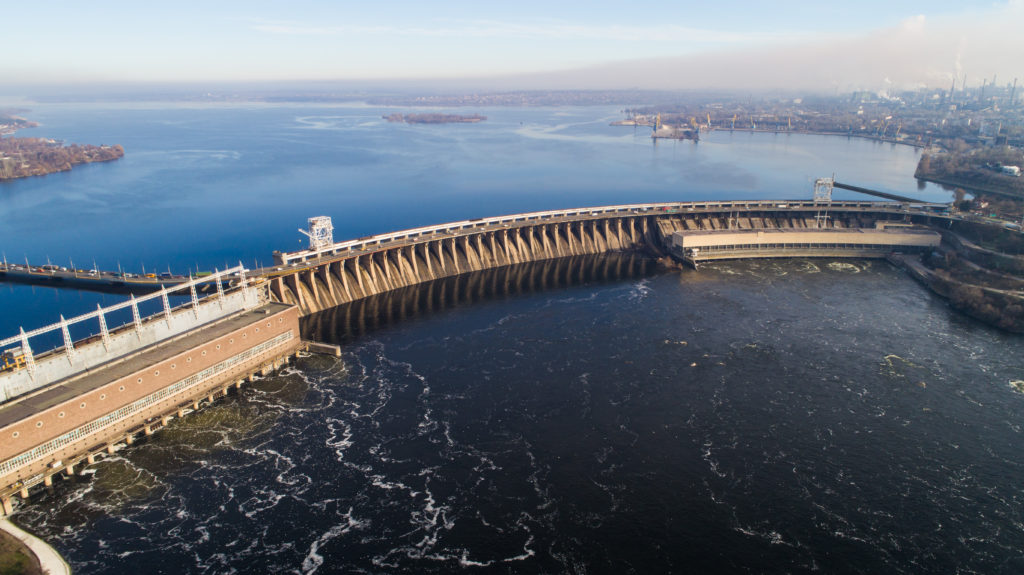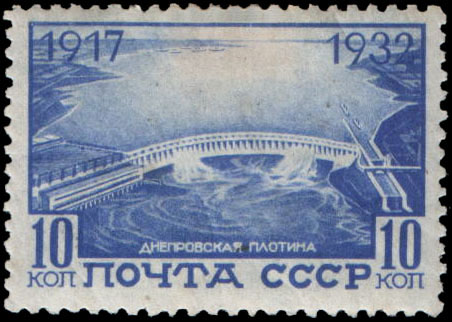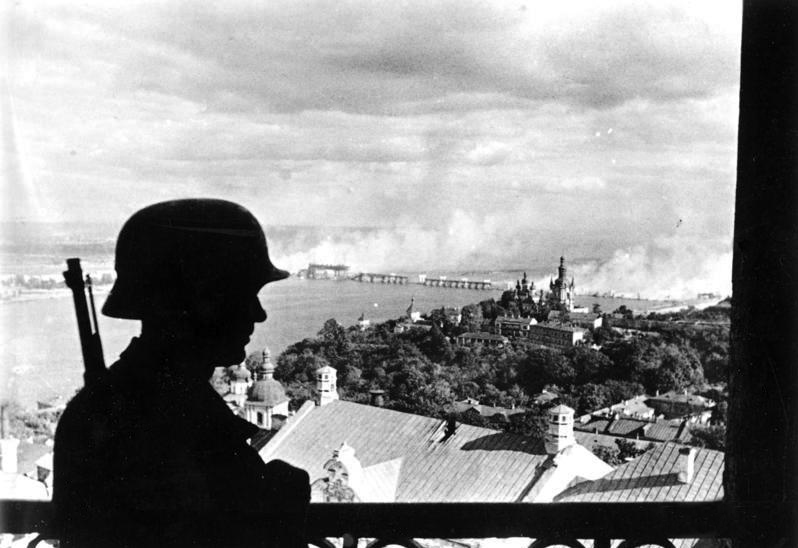Dnieper. Dnipro. Dnepr. Dnyapro. No matter how you spell it, the name of this river is a tongue-twister. It can get worse, though. The Dnieper Dam (we’ll use the predominant English spelling, if you don’t mind) impounds the Dnieper River just upstream from the town of Zaporizhzhya! Spelling aside, the river and dam are among the most important in Europe.

The Dnieper River is the fourth largest in Europe (behind the Volga, Danube and Ural; maybe third if you consider the Ural River in Asia). It flows more than 1,350 miles, from headwaters in Belarus and Russia, through the Ukraine (it bisects the capital, Kiev), and emptying into the Black Sea. The watershed includes 80% of Ukrainian water resources, making the river essential to the economy of that nation. The river is also an important cultural symbol for Ukrainians.
A set of rapids just upstream of Zaporizhzhya had always made the river un-navigable. Plans to dam the river go back to the 1800s, but they got serious during communist rule when the Ukraine was part of the USSR. Leon Trotsky, famous (or perhaps infamous) Soviet leader, said, “In the south, the Dnieper runs its course through the wealthiest industrial lands; and it is wasting the prodigious weight of its pressure, playing over age-old rapids and waiting until we harness its stream, curb it with dams, and compel it to give lights to cities, to drive factories, and to enrich ploughland. We shall compel it!” Damming the Dnieper River became a central focus of the utilitarian communist philosophy.

Construction of the dam began in 1927 and was completed in 1932. The US government provided expertise, and General Electric built the electric-generating turbines. On October 10, 1932, the dam began operation. The dam was nearly 2500 feet long and 200 feet high, and it flooded the upstream rapids. The power-generating capacity was the largest in Europe until the 1950s when larger facilities were built on the Volga River. The dam included a series of locks that made almost the entire Dnieper River navigable.
All of this, you might think, is rather ho-hum today. Big dams that generate electricity and allow river transportation are commonplace. And, like the Dnieper Dam, big dams often hold great cultural importance to the nations that build them (Hoover Dam, remember, was considered the epitome of American can-do personality in the 1930s). But what happened to the Dnieper Dam got pretty spectacular during World War II.

Early in the war, the Soviet Union was getting badly beaten by Nazi Germany. German troops were advancing through the Ukraine, headed toward Kiev. The forerunners of the Soviet KGB, on orders from Joseph Stalin, blew up Dnieper Dam on August 18, 1941. Rather than let the Germans take over the hydro-electric facility and the city of Kiev, the USSR destroyed their great work. An American journalist at the time reported, “I know what that dam meant to the Bolsheviks…It was the largest, most spectacular, and most popular of all the immense projects of the First Five-Year Plan…. Its destruction demonstrates a will to resist, which surpasses anything we had imagined.”
That will to resist also created an enormous human tragedy. A film of the dam’s destruction shows the central portion of the dam erupting, and water from the reservoir behind the dam flowing through the gap like a raging river. People living downstream had no warning as village after village was ripped apart. No official count of the dead is available, but estimates range from 20,000 to 100,000 human casualties. Dam tragedies are bad enough when the result of weather, but they are unspeakable when done on purpose.
The Germans took over the area and partially rebuilt the dam. But two years later, the course of the war had reversed, and Soviet troops were now pushing the Germans back out of the Ukraine. As they retreated, the German forces blew up the dam for a second time! This time, the dam was virtually obliterated.
But this is a dam that wouldn’t die. At the end of the war, the Soviets rebuilt the dam for a third time, again with the help of the U.S. and General Electric. After five years of construction, in, 1950, the dam again began producing electricity.
The Dnieper Dam remains in operation today, producing electricity and impounding a large reservoir that allows river transportation through its system of locks. It is less significant than before, now serving as just one element in a network of dams and fuel-burning electric plants. But it remains a symbol of the resilience and sustainability, not only of the Ukraine, but also nature.
References:
Andrews, Stefan. 2017. The Red Army troops dynamited the strategically important Dneprostroi Dam during WWI, as Germany invaded the Soviet Union. The Vintage News, Jan 13, 2017. Available at: https://www.thevintagenews.com/2017/01/13/the-red-army-troops-dynamited-the-strategically-important-dneprostroi-dam-during-wwii-as-germany-invaded-the-soviet-union/. Accessed February 4, 2020.
Internet Encyclopedia of Ukraine. Dnipro Hydroelectric Station. Available at: http://www.encyclopediaofukraine.com/display.asp?linkpath=pages%5CD%5CN%5CDniproHydroelectricStation.htm. Accessed February 4, 2020.
Micklin, Philip P., and Anatoly Petrovich Domanitsky. Dnieper River. Encyclopedia Britannica. Available at: https://www.britannica.com/place/Dnieper-River/Hydrology. Accessed February 4, 2020.
Moroz, Dmytro. 2013. Ukrainian Activist Draw Attention To Little-Known WWII Tragedy. Radio Free Europe, August 23, 2013. Available at: https://www.rferl.org/a/european-remembrance-day-ukraine-little-known-ww2-tragedy/25083847.html. Accessed February 4, 2020.
